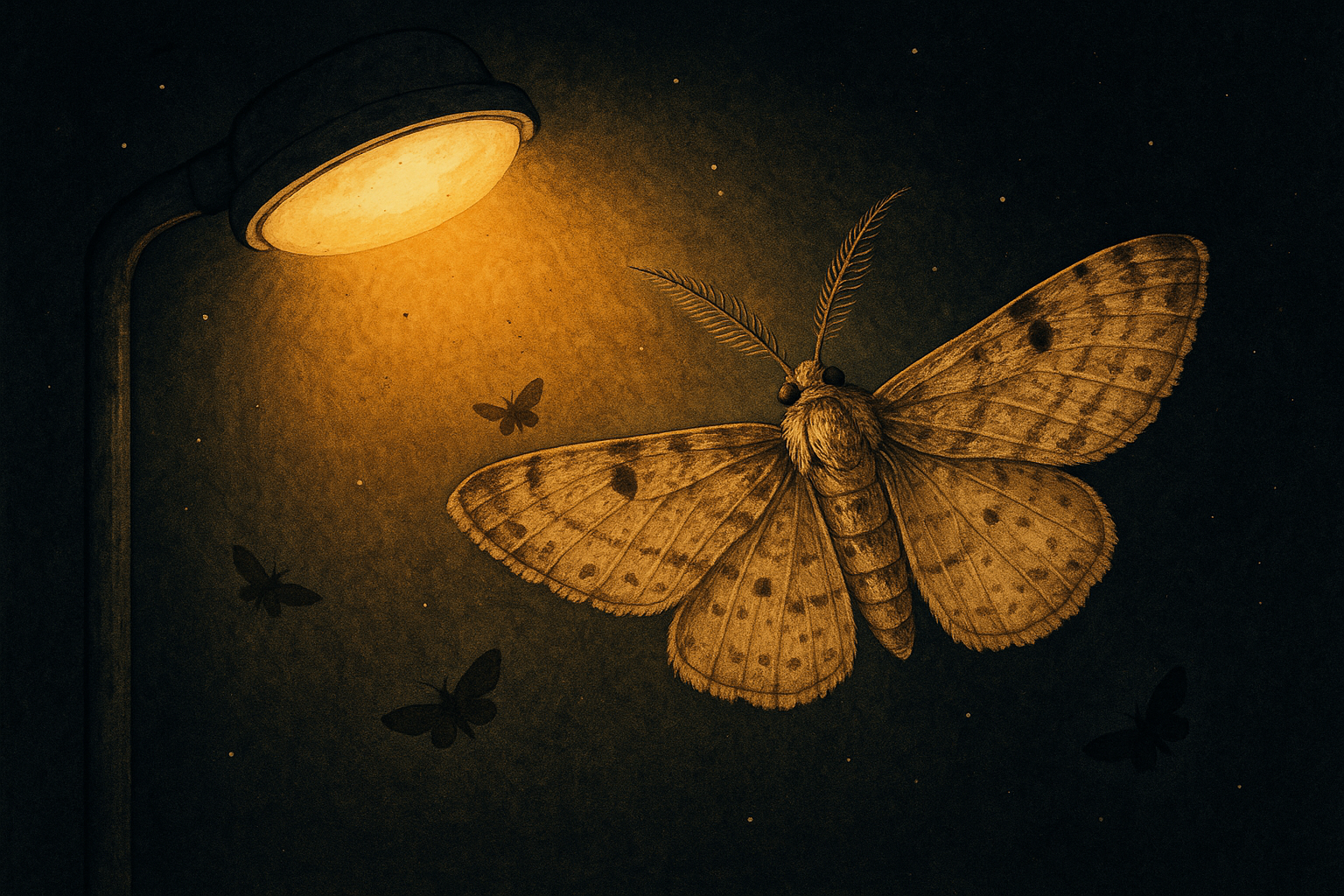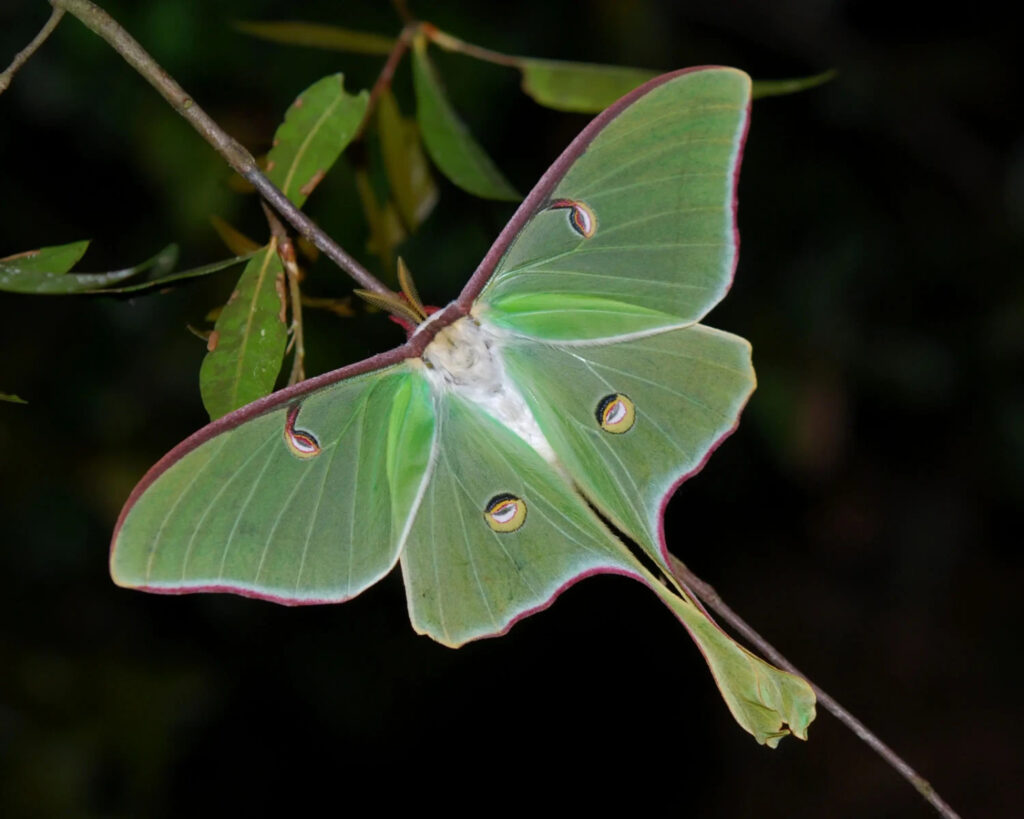Like Moths to a Flame: The Impact of Light Pollution on Moths
By Livian Von Dran

The proverb “like a moth to a flame” refers to an attraction to something harmful—dangerous, even. The phrase stems from the apparent fixation moths have with light, to the point of memetic notoriety. This stereotype holds some truth for one reason: light pollution. Known to disproportionately impact nocturnal insects, this unconventional form of pollution manifests itself as artificial light that exceeds the natural light levels seen in the surrounding environment.9
Moths and butterflies are insects that comprise the order Lepidoptera, but moth species are far more numerous; 91% of described lepidopteran species are moths, and they make up 118 of the 125 families in the order.5 Though they are perhaps thought of by some people as butterflies’ uglier cousins, the taxonomic diversity of moths is accompanied by varied and spectacular morphologies. One species known for its beauty is the luna moth (Actias luna). Most moths are nocturnal, limiting their public exposure and subsequent popularity.6
As visibility is limited at night, moths must rely on specialized navigation methods, though the exact mechanism of this navigation has not been confirmed. The most popular, well-supported hypothesis is transverse orientation. This occurs when an insect maintains a constant angle to a distant light source—often celestial bodies like the Moon—to assist in navigation.7 If the object is far enough away, then the angle between the insect and light source remains fixed. Maintaining this angle allows the insect to continuously fly in a straight line.7

Instead of being an object of obsession, artificial light sources cause disorientation in moths due to their close proximity. Moths cannot distinguish these light sources from distant celestial bodies, so when disoriented by these lights, they must constantly shift their bodies to maintain the correct angle. Studies have suggested insects will instinctively turn their dorsum—their upper backs—toward a light source to maintain orientation and control during flight; when a nearby artificial light disorients an insect, this dorsal light response causes a continuous steering effect that creates a spiral flight pattern around the light.3
As the world brightens, the outlook for moths grows dim.
Approximately 23% of the world’s area experiences some degree of light pollution—an area that is continuously expanding.1 This correlates with decreasing moth populations in various parts of the world, including Europe; in Great Britain, a survey found a 25% decrease in indicator species between 1970 and 2016.1 Population decreases are attributable to moths having less energy available for reproduction; moths feed less frequently under the presence of artificial light.7 Unfortunately, inhibited feeding decreases nighttime pollination rates, as decreased flower visitation reduces pollen spread.8 As plants often compose the producer backbone of an ecosystem, restriction of the nocturnal pollinator niche can cause cascading effects throughout an entire ecosystem.
Despite its negative impacts, an ironic bright side exists: light pollution is completely reversible.
The complete cessation of light usage would revert the night sky to its original celestial glory. Unfortunately, cutting out all the lights is impractical; some level of artificial light is necessary to promote modern society’s need for safety and visibility.10 With this in mind, mitigation efforts should be centered on curtailing the impacts of artificial light; naturally unlit areas should be maintained, and when this is not possible, lighting intensity and trespass into unlit areas should be minimized.4 Success stories happen when communities, parks, and protected areas implement these strategies—successes DarkSky International recognizes as International Dark Sky Places.2
References
1Boyes, D. H., Evans, D. M., Fox, R., Parsons, M. S., & Pocock, M. J. O. (2020). Is light pollution driving moth population declines? A review of causal mechanisms across the life cycle Insect Conservation and Diversity, 14(2), 167–187. https://doi.org/10.1111/icad.12447
2DarkSky International. (2018, June). International Dark Sky Reserve Program Guidelines. https://darksky.org/app/uploads/2018/12/IDSR-Guidelines-2018.pdf
3Fabian, S. T., Sondhi, Y., Allen, P. E., Theobald, J. C., & Lin, H.-T. (2024). Why flying insects gather at artificial light. Nature Communications, 15(1), 1-15. https://doi.org/10.1038/s41467-024-44785-3
4Gaston, K. J., Davies, T. W., Bennie, J., & Hopkins, J. (2012). Reducing the Ecological Consequences of Night-time Light pollution: Options and Developments. Journal of Applied Ecology, 49(6), 1256–1266. https://doi.org/10.1111/j.1365-2664.2012.02212.x
5Heppner, J. B. (2008). Moths (Lepidoptera: Heterocera). Encyclopedia of Entomology (pp. 2491-2494). Springer Dordrecht. https://doi.org/10.1007/978-1-4020-6359-6_4705
6Kawahara, A. Y., Plotkin, D., Hamilton, C. A., Gough, H., St Laurent, R., Owens, H. L., Homziak, N. T., & Barber, J. R. (2017). Diel behavior in moths and butterflies: a synthesis of data illuminates the evolution of temporal activity. Organisms Diversity & Evolution, 18(1), 13–27. https://doi.org/10.1007/s13127-017-0350-6
7Li, Z., Zhou, Y., Zhang, S., & Song, J. (2016). Lévy-Flight Moth-Flame Algorithm for Function Optimization and Engineering Design Problems. Mathematical Problems in Engineering, 2016(1), 1-22. https://doi.org/10.1155/2016/1423930
8MacGregor, C. J, Pocock, M. J., Fox, R., & Evans, D. M. Pollination by nocturnal Lepidoptera, and the effects of light pollution: a review. Ecological Entomology, 40(3), 187–198. https://doi.org/10.1111/een.12174
9Mayer-Pinto, M., Jones, T. M., Swearer, S. E., Robert, K. A., Bolton, D., Aulsebrook, A. E., Dafforn, K. A., Dickerson, A. L., Dimovski, A. M., Hubbard, N., McLay, L. K., Pendoley, K., Poore, A. G. B., Thums, M., Willmott, N. J., Yokochi, K., & Fobert, E. K. (2022). Light pollution: a landscape-scale issue requiring cross-realm consideration. UCL Open Environment, 4. https://doi.org/10.14324/111.444/ucloe.000036
10Stone, T. (2017). Light Pollution: A Case Study in Framing an Environmental Problem. Ethics, Policy & Environment, 20(3), 279–293. https://doi.org/10.1080/21550085.2017.1374010
11van Langevelde, F., van Grunsven, R. H. A., Veenendaal, E. M., & Fijen, T. P. M. (2017). Artificial night lighting inhibits feeding in moths. Biology Letters, 13(3), 1-4. https://doi.org/10.1098/rsbl.2016.0874
